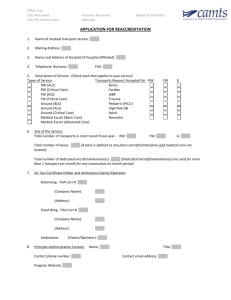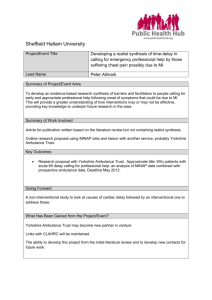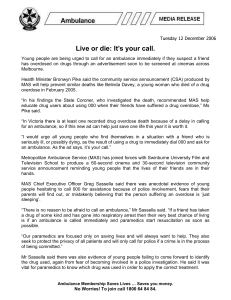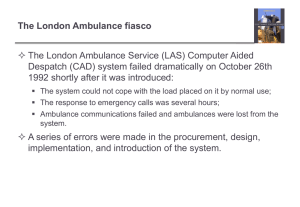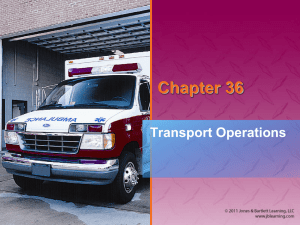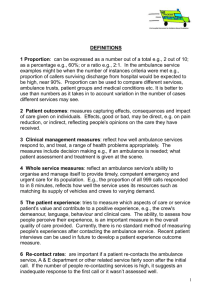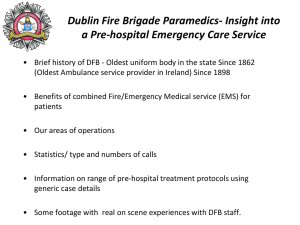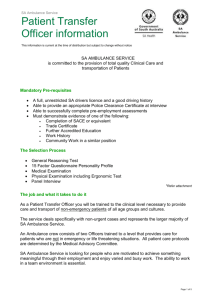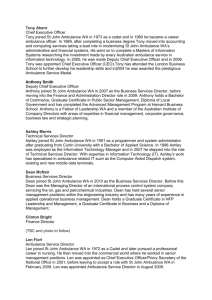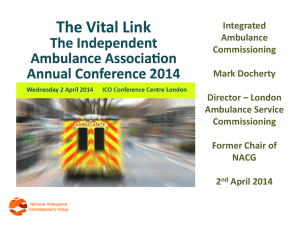Simultaneous Dispatch
advertisement
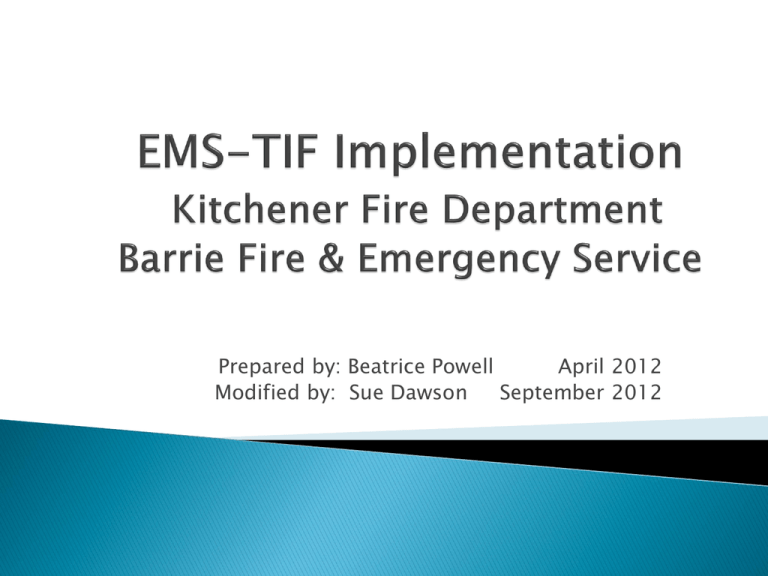
Prepared by: Beatrice Powell April 2012 Modified by: Sue Dawson September 2012 Fire Involvement Goals of EMS-TIF project EMS-TIF & CADFusion interface- how it works Preparation for EMS-TIF implementation ◦ System preparation ◦ Testing ◦ Training ◦ Implementation / Go Live Considerations Fire Services Advisory Group has members from Ontario Fire Marshal’s Office, Ontario Association of Fire Chiefs, Ontario Professional Fire Fire Association of Ontario and Fire Fighters Association of Ontario. OAFC has lobbied for simultaneous notification / been part of project for some time Fire participation was voluntary. Site selection principles and approved by Fire Services Advisory Group. Shorten call handling time for both Ambulance & Fire Share better information, faster End result> faster overall emergency response to the public. Telus circuit installed at HQ ◦ Allows secure communication between Ambulance / Ministry of Health / Fire ◦ Will require IT and CAD Vendor involvement Review tiered response agreements for all Fire Departments dispatched for, to ensure they align with DPCI codes in use by Ambulance ◦ Map DPCI codes / tiered agreements to CriSys incident types. ◦ May need to change or create new incident types Review data sharing documents provided by Ministry of Health > Data Mapping MOH provides list of items they will send, either in initial data burst or as updates Address information (incl. coordinates), location information, hazards, cautions, incident type, updates from scene, access codes, comments, etc. Fire identifies ‘where’ in Fire CAD these items should go. MOH provides ‘wish list’ of data items they would like from Fire Call acknowledgement, whether Fire is responding, time Fire is on scene, updates from scene, Fire ETA, hazards, etc. Fire identifies which elements they can provide and from where Most data shared with Ambulance is based on: ◦ Unit status- Fire Dispatched & On Scene ◦ Benchmarks Review all benchmarks and organize so they are easy to use. All medical benchmarks are in one menu. ◦ Site details & Site hazards Identified types automatically shared when call from ambulance is acknowledged Identify types to share- for all departments dispatched for…everyone needs a full understanding of what data is being shared Clean up content! Once interface configuration is complete, testing can begin. Testing occurs, end to end, with Ministry of Health / CACC, over conference calls. Numerous test cycles involving test scenarios at both ends. Define test scenarios ◦ Typical medical call handling scenarios ◦ Known problematic situations ◦ Fire can identify scenarios. Kitchener identified 28 ◦ Review scenarios with CACC- they had good input! Create test cases based on scenarios ◦ Define inputs / outputs ◦ Some scripting may be helpful to make sure testing captures all situations Create a test log where you can document all issues and their follow up actions. Standard medical call Standard medical call with address & other updates Medical call to no-match address Medical call to highway location Linking a medical call to an existing Fire incident, e.g. an MVC that Fire receives from Police before Ambulance Etc. Numerous test cycles, end to end with Ministry of Health Parallel production sessionsSimulation/shadowing of actual medical calls at both Fire & Ambulance “Day in the life” sessionsscripted ‘typical’ day, performed end to end with staff from Fire & Ambulance Pre-read / self directed training materials for both Communications & Suppression. Creation of videos showing a full range of medical call handling scenarios- based on test scenarios. One-on-one training using videos, approximately one hour with opportunity for questions. Some opportunity to participate in coordinated training with Ambulance staff. Opportunities to ‘practice’ in Parallel Production Environment, ie. Shadowing actual calls at both ends. CriSys will install to our Live system and turn on the listener to receive calls from CACC. Support plan for EMS-TIF connection issues to be in place. Contract dispatch customers and Kitchener Suppression crews have received information packages regarding what to expect when EMS-TIF is live. All Communications staff are now trained. Once Live, assessment of call handling & overall emergency response time savings to be performed. Address Data from Ambulance ◦ Not currently in 911 PERS format ◦ May get addresses that do not match, address ranges, etc. ◦ May get coordinates only, but always with a description of location. E.g. location in a park ◦ Will always get coordinates which locate the call correctly & enable you to start a response without needing a matched address. Trip Ticket Content ◦ All notes, including those from Ambulance, which are on the call prior to dispatch, will appear on the trip ticket. There may be an increase in volume of information received. ◦ No patient name is ever included, but condition and location are. This is sensitive and private information. ◦ Consider policies and procedures around secure trip ticket disposal. ◦ May need to accommodate extra information on trip tickets, i.e. decrease font size to make room on sheet. Content of data shared with Ambulance ◦ Consider policies around what is entered into CAD. ◦ If Site Details and Site Hazards are being shared, they should be maintained properly and have some input guidelines around them. ◦ Consider expectation of confidentiality. Time Sync’ing ◦ Fire and Ambulance CAD times are not always in sync. ◦ Consider pursuing solution to address this issue. ◦ Has impact on statistics when mixing times from two systems. Overall, an interesting and valuable experience which provided opportunities to streamline processes and improve information flow and content, in addition to achieving call handling time savings. Implementation time has been significant, but as early adopters, this was anticipated. Any future adopters would not likely have to commit as much time. Opportunity to significantly improve emergency response times and literally save more lives – this is worth the effort invested. This is a significant enhancement to customer service and community safety.
